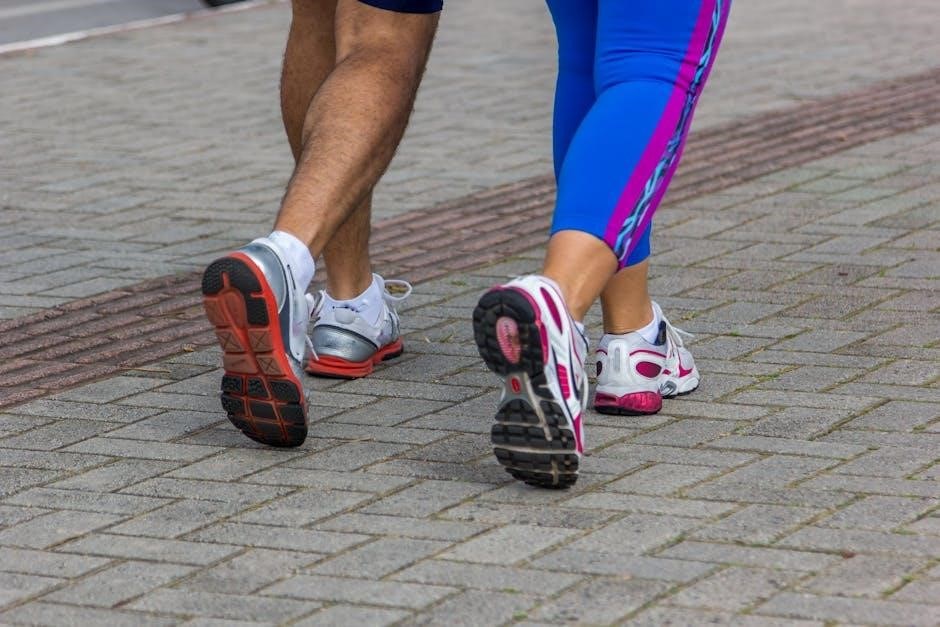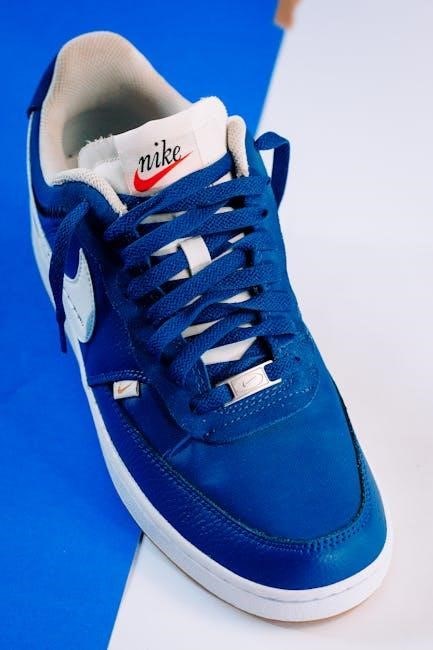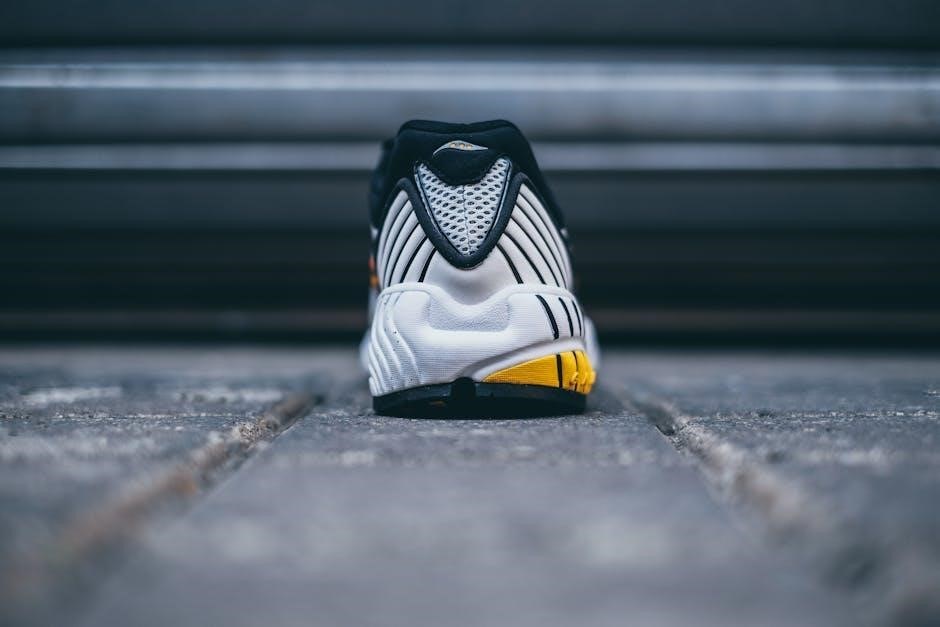Importance of Proper Running Shoe Fit
Proper running shoe fit is crucial for optimal performance and injury prevention. Snug yet comfortable shoes minimize discomfort, reduce injury risk, and enhance overall running efficiency.
1.1. Why Proper Fit Matters for Performance and Injury Prevention
A proper running shoe fit is essential for maximizing performance and minimizing injury risks. Ill-fitting shoes can lead to discomfort, poor running form, and increased stress on joints. A snug, supportive fit ensures optimal energy transfer with each stride, while adequate toe space prevents toenail issues. Properly fitted shoes also reduce friction and blisters, allowing runners to maintain consistency and achieve better results.
1.2. How Ill-Fitting Shoes Can Lead to Discomfort or Injuries
Ill-fitting running shoes can cause significant discomfort and increase injury risk. Tight shoes compress the feet, leading to pain, numbness, and restricted movement. Loose shoes result in slipping, causing blisters and instability. Poor fit also alters running mechanics, straining muscles and joints. Over time, this can lead to issues like plantar fasciitis, shin splints, or toenail damage, ultimately disrupting training consistency and overall performance.

How to Measure Your Feet Correctly
Measure your feet by standing on paper, marking the heel and longest toe. Measure length and width, ensuring accuracy. Both feet should be measured, as sizes can differ. Repeat at the end of the day for accuracy, as feet swell naturally. This ensures proper fit and comfort in running shoes.
2.1. Step-by-Step Guide to Measuring Foot Length and Width
Place your foot on a flat surface with weight evenly distributed. Trace the outline on paper. Measure the longest toe to the back of the heel for length. Width is measured across the ball of the foot. Use a ruler to record both measurements accurately. Repeat for both feet, as sizes may differ slightly, ensuring a precise fit for running shoes.
2.2. Best Practices for Accurate Foot Measurement
Measure feet at the end of the day, as they naturally swell. Stand while measuring to account for foot expansion. Use a Brannock device or ruler for accuracy. Trace both feet separately, as sizes may differ. Ensure the foot is flat and weight-bearing. Consider the thickness of socks worn during runs. Double-check measurements for consistency to ensure the best fit for running shoes.
Understanding Shoe Size Conversion Charts
Shoe size conversion charts help translate sizes across US, European, and UK systems, ensuring accurate fit. Use recent foot measurements, as sizes vary slightly between brands and regions.
3.1. Differences Between US, European, and UK Shoe Sizes
US, European, and UK shoe sizes differ due to varying measurement systems. US sizes are based on the Brannock system, while European sizes use Paris points and UK sizes align closely with European standards. Conversion charts help translate sizes, but slight variations exist between brands. Always use recent foot measurements for accurate conversions to ensure proper fit and comfort.
3.2. How to Convert Women’s to Men’s Shoe Sizes
To convert women’s shoe sizes to men’s, add 1.5 to 2 sizes. For example, a women’s size 8 is roughly a men’s size 9.5. Use a unisex sizing chart for accuracy, as differences in fit and comfort can vary between brands. Proper conversion ensures optimal fit, reducing discomfort and potential injury during runs. Always consider individual foot shape and shoe width for the best results.
Key Aspects of Running Shoe Fit
Proper fit ensures comfort and support, with adequate toe space and a snug midfoot and heel; This balance prevents discomfort and injuries while optimizing performance.
4.1. Toe Fit: Ensuring Adequate Space for Comfort
A proper toe fit is essential for comfort and injury prevention. Ensure a thumb’s width of space between your longest toe and the shoe’s end. This allows natural toe movement, preventing blisters and discomfort. Proper toe room enhances running efficiency and reduces the risk of toe-related injuries, ensuring a more enjoyable and pain-free running experience overall.
4.2. Midfoot and Heel Fit: Finding the Right Snugness
The midfoot and heel should feel snug but not overly tight, providing stability without restricting movement. A proper fit ensures minimal slipping during runs while maintaining comfort. The heel should fit securely to prevent excessive movement, and the midfoot should offer a balanced level of support and flexibility, contributing to a stable and efficient running experience.
Trying on Running Shoes
Try shoes at the end of the day, as feet swell naturally. Wear your usual running socks and orthotics for an accurate fit assessment.
5.1. When to Try Shoes On: Time of Day Matters
Try running shoes at the end of the day, as feet naturally swell throughout the day. This ensures a more accurate fit, preventing shoes from feeling too tight during runs. Proper timing helps avoid discomfort and potential injuries. Wearing your usual running socks and orthotics during fittings is also crucial for an accurate fit assessment.
5.2. What to Wear: Socks and Orthotics
Wear your usual running socks when trying on shoes to ensure proper fit and comfort. If you use orthotics or insoles, bring them along to test the fit. This helps determine if the shoe accommodates your foot support needs without feeling too tight or restrictive. Proper sock and orthotic fit ensures optimal comfort and prevents discomfort or blisters during runs.

Foot Shape and Shoe Width
Foot shape and shoe width play a crucial role in comfort and performance. Different foot shapes require specific widths for optimal fit. Understanding your foot shape helps choose the right width, ensuring comfort and support during runs.
6.1. Understanding Narrow, Standard, and Wide Widths
Shoe widths cater to different foot shapes: narrow, standard, and wide. Narrow widths suit slimmer feet, while wide widths accommodate broader feet. Standard width is the most common, offering a balanced fit. Understanding your foot shape and selecting the right width ensures comfort, prevents discomfort, and enhances performance during runs. Proper width alignment is key to optimal support and mobility.

6.2. How to Determine Your Foot Shape
To determine your foot shape, trace your foot on paper or use a Brannock device. Measure the width at the ball of the foot. Compare it to standard shoe width charts. If your foot is narrower or wider than average, opt for narrow or wide widths. This ensures a comfortable fit and proper support, enhancing running performance and reducing discomfort.

Running Style and Shoe Fit
Your running style, including pronation and terrain, influences shoe fit. Proper cushioning and support ensure comfort and performance, reducing injury risks during runs.
7.1. Pronation and Its Impact on Shoe Choice
Pronation significantly impacts running shoe choice, as it affects how the foot strikes the ground. Overpronation requires shoes with additional support and stability features, while neutral pronation suits cushioned styles for a smoother ride. Supination, or underpronation, benefits from shoes with more durable outsoles to handle higher impact. Selecting shoes tailored to your pronation type ensures better comfort, reduces injury risks, and optimizes overall performance during runs.

7;2. How Running Terrain Affects Fit Preferences
Running terrain greatly influences shoe fit preferences. Trail running requires shoes with superior traction and durability, while road running prioritizes cushioning and breathability. For track or speed workouts, a snugger fit and lightweight design are ideal. Understanding your primary running environment helps tailor shoe choice, ensuring optimal performance, comfort, and protection across varying surfaces and conditions.

Common Mistakes to Avoid
Common mistakes include buying shoes too tight or too loose, ignoring foot swelling during runs, and not ensuring proper toe and heel fit for comfort.
8.1. Buying Shoes That Are Too Tight or Too Loose
Buying shoes that are too tight can cause discomfort, blisters, and injuries like bunions or toenail issues. Conversely, shoes that are too loose may lead to foot sliding, poor stability, and increased risk of blisters. Proper fit ensures a snug yet comfortable feel, allowing a thumb’s width of space for toes and a secure midfoot and heel. Avoiding these extremes is key for optimal performance and injury prevention.
8.2. Not Considering Foot Swelling During Runs
Not accounting for foot swelling during runs can lead to discomfort and injury. Feet typically swell during exercise due to increased blood flow and friction. Shoes that fit perfectly at rest may feel too tight mid-run, causing blisters or restricting movement. Ensuring a half-size larger fit helps accommodate swelling, providing comfort and reducing the risk of discomfort or injury during long runs.
Using Technology for Better Fit

Foot scanners and 3D fit technology provide precise measurements, ensuring optimal shoe fit. Online fit finders use data to recommend sizes, enhancing comfort and performance for runners.
9.1. Foot Scanners and 3D Fit Technology
Foot scanners use 3D technology to create precise foot measurements, ensuring accurate shoe fit. This advanced tool analyzes foot shape, arch height, and length to recommend ideal sizes. It minimizes sizing errors and enhances comfort by providing a personalized fit. Some systems even offer real-time comparisons with various shoe models, making it easier to find the perfect match for your foot shape and running style.
9;2. Online Fit Finders and Shoe Recommendation Tools
Online fit finders use algorithms to analyze foot shape, running style, and preferences, offering personalized shoe recommendations. Tools like the Road Runner Sports Fit Finder ask detailed questions about running habits and foot shape to suggest ideal models. These platforms save time and improve fit accuracy, ensuring better comfort and performance. They often include customer reviews and expert insights for added reliability.
Final Check Before Purchasing
Before purchasing, ensure the shoes feel comfortable during walking and running. Check for adequate support and a snug fit without tightness. Your satisfaction is the key.
10.1. Walking and Running in the Store
Always try shoes on at the end of the day, as feet swell naturally. Walk and run in the store to ensure comfort and support. A proper fit should allow a thumb’s width for toes, with a snug midfoot and heel. Use tools like the Road Runner Sports Fit Finder for personalized recommendations to ensure the best fit for your needs and satisfaction.
10.2. Checking for Comfort and Support
Ensure the shoe offers a snug, comfortable fit with adequate support. The toe box should allow a thumb’s width of space, preventing compression. The midfoot and heel should feel secure without tightness. Proper cushioning and alignment are crucial to avoid discomfort or injury during runs. If the fit feels off, consider a different size or model to ensure optimal performance and satisfaction.

Maintaining Your Running Shoes
Regularly clean and dry shoes to prevent odor and damage. Store them in a cool, dry place to maintain shape and extend lifespan.
11.1. When to Replace Your Running Shoes
Replace running shoes every 300-500 miles or when showing signs of wear. Look for soles with excessive wear, loss of cushioning, or damaged uppers. If shoes no longer provide support or comfort, it’s time to replace them to prevent discomfort or injury during runs.

11.2. Caring for Your Shoes to Extend Their Lifespan
Proper care extends shoe lifespan. Clean shoes with a soft cloth and mild soap, avoiding harsh chemicals. Allow them to air dry, as heat can damage materials. Stuffing with newspaper absorbs moisture. Rotate pairs to prevent overuse. Store in a cool, dry place. Avoid machine washing, as it can degrade materials and adhesives. Regular maintenance ensures optimal performance and longevity.